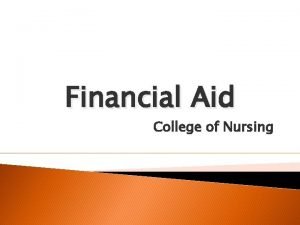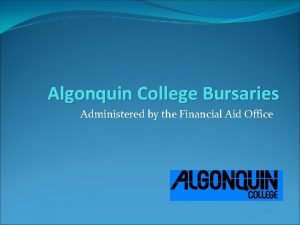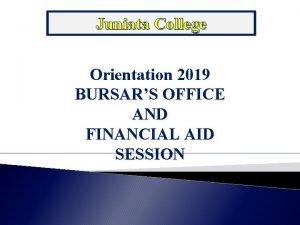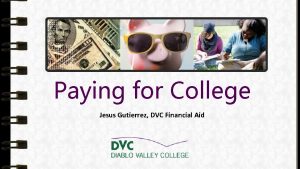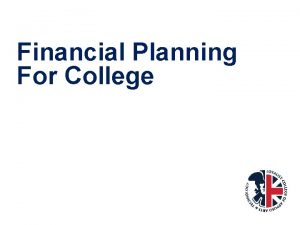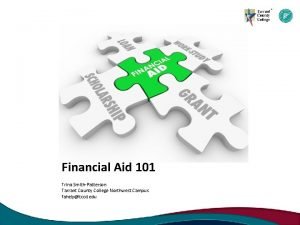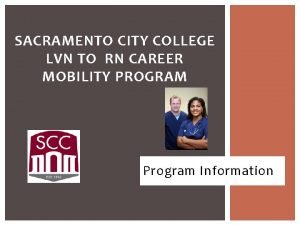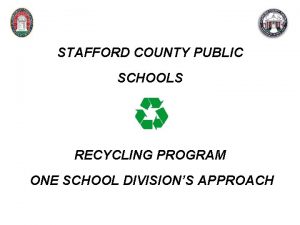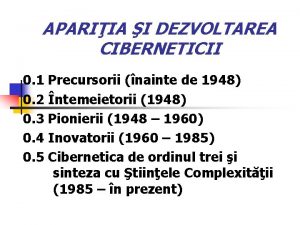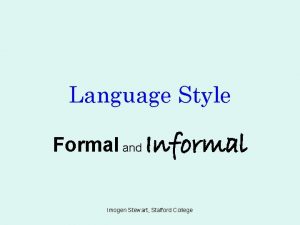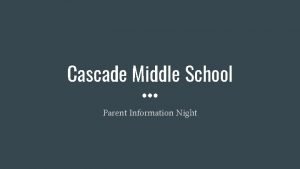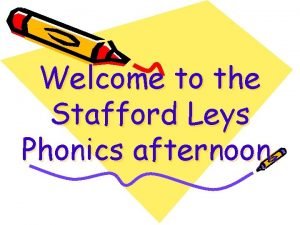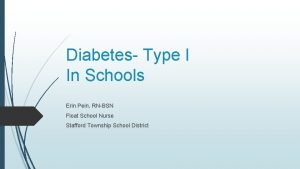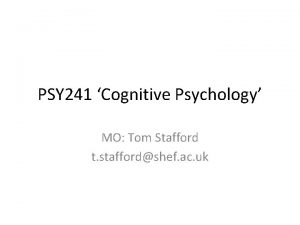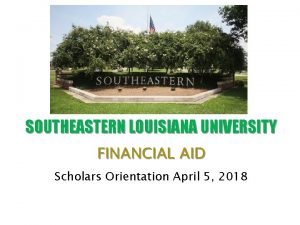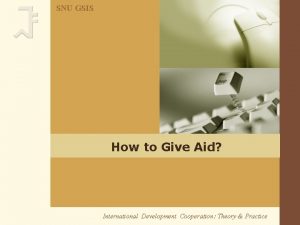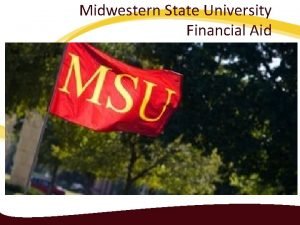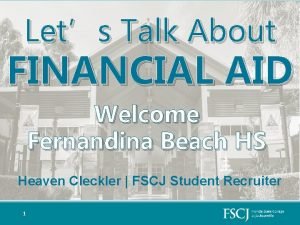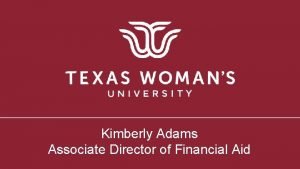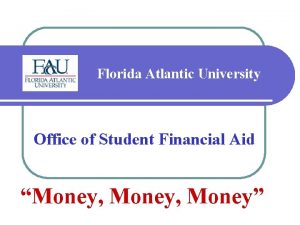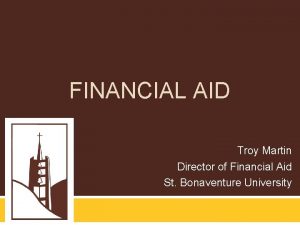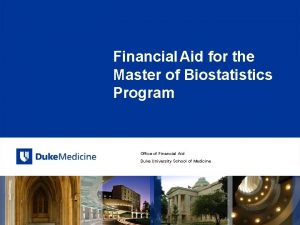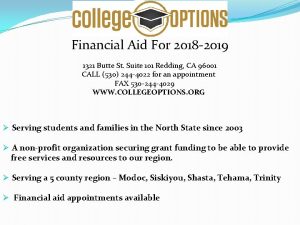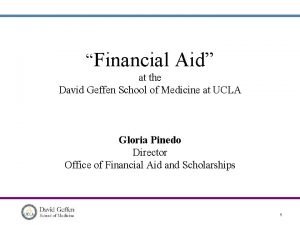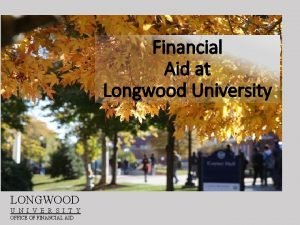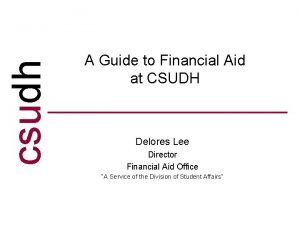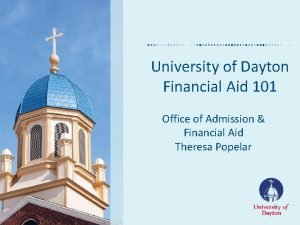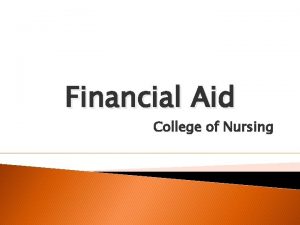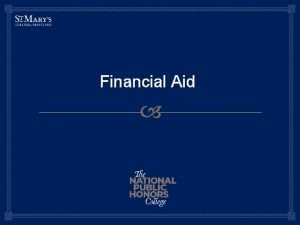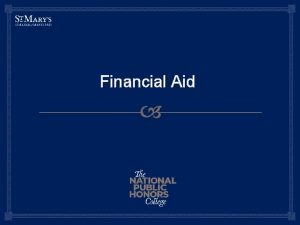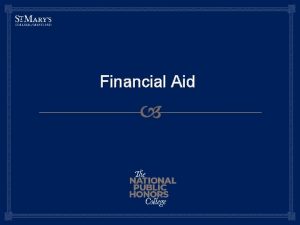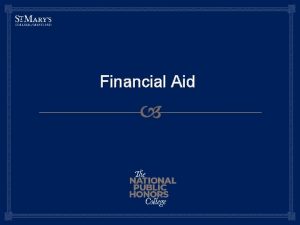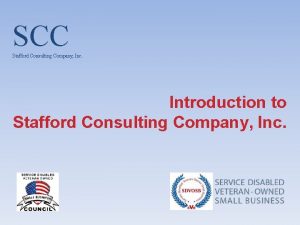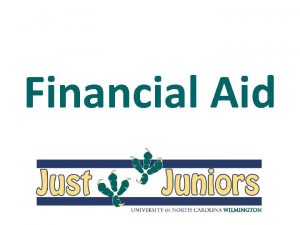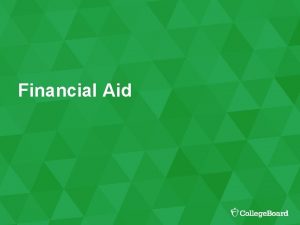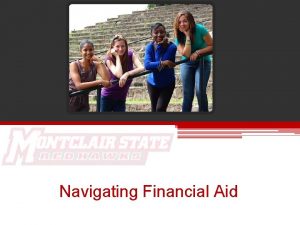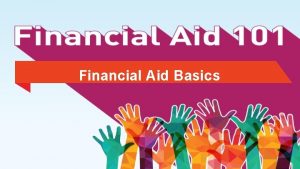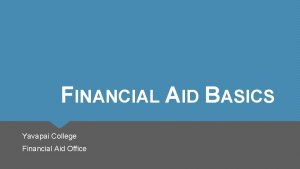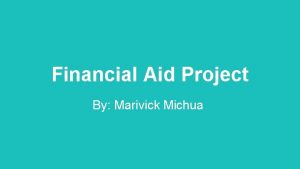Financial Aid College of Nursing Federal Direct Stafford







































- Slides: 39

Financial Aid College of Nursing

Federal Direct Stafford Loan � DNP students can borrow $20, 500 ◦ 6. 8% Interest ◦ No payments while in school ◦ Payments begin six months after graduation � Aggregate Limit = $138, 500

Perkins � $4, 000 ◦ ◦ per year MAY be awarded 5% interest No payments while in school Payments begin nine months after graduation Based on financial need and availability of funds

Federal Direct Graduate PLUS Loan � Can be eligible for the difference between Cost of Attendance and other aid being received. ◦ ◦ Based on credit (co-signer) 7. 9% interest No payments while in school Payments begin six months after graduation � www. studentloans. gov

Additional Funds Request Form http: //www. uthsc. edu/finaid/documents/Additional. Funds. Request. pdf

Other loan options � Nursing Student Loan http: //bhpr. hrsa. gov/dsa/sfag/nursing_programs/bk 2 prt 1. htm. � Health (HRSA) Resources and Services Administration http: //bhpr. hrsa. gov/nursing/grants/aent. html

2013 -2014 In-State (1 st Yr)Cost of Attendance ESTIMATE �Tuition �Fees �Books and Supplies �Living Expenses Total $16, 442 $4, 802 $1, 540 $23, 256 $46, 040

2013 -2014 Out-of-State (1 st yr) Cost of Attendance ESTIMATE � Tuition � Fees � Books and Supplies � Living Expenses Total $39, 626 $4, 802 $1, 540 $23, 256 $69, 224

In-state packaging example COA = $46, 040 � $20, 500 Direct Unsubsidized Loan � $4, 000 Perkins Loan � $21, 540 Graduate PLUS Loan $46, 040 *Scholarships will decrease loan amounts

Out-of-state packaging example COA = $69, 224 � $20, 500 Direct Unsubsidized Loan � $4, 000 Perkins � $44, 724 Graduate PLUS Loan $69, 224 *Scholarships will decrease loan amounts

Estimated Refund � In-state $46, 040 Total Aid -$16, 442 Tuition & Fees $29, 598 Refund -$1, 540 Books & Supplies � Out-of-state $69, 224 Total Aid -$39, 626 Tuition & Fees $29, 598 Refund -$1, 540 Books & Supplies $14, 029 per semester $9, 780 per semester$11 $9, 780 per semester

Applying for Financial Aid � PIN: ◦ www. pin. ed. gov � FAFSA Application: ◦ www. fafsa. ed. gov (School code: 006725) � Loan History: ◦ www. nslds. ed. gov � AAMC: ◦ www. aamc. org/stloan

One-Stop-Shop � Located in 910 Building on the 1 st floor (across from the Sun Trust Bank) � Services available: - Financial aid - Bursar Office - Registrar Office � IT (information technology tech. ): 11: 00 am – 2: 00 pm and 4: 00 pm – 5: 00 pm beginning August 2 -20, 2013.

One-On-One - Must have a one-on-one counseling with financial aid counselor. - Skype Telephone Office Visit - MANDATORY!!!!!

Banner Self-Service

Contact Information Ms. Jacquelyn Le. Sueur Financial Aid Counselor College of Nursing (901) 448 -8324 jlesueur@uthsc. edu Skype: jacquelyn. lesueur

Financial Literacy Managing your Money � What is Financial Literacy – It’s the ability to understand money and how to manage it so that you can make informed financial decisions – to save, manage and better protect their money. Help you prepare for the unexpected events and plan for the short or long-term goals.

Budgeting � Establishing a budget and sticking to it isn’t easy, but it’s the best way to be in control of your finances and make sure your money is going toward the expenses that matter most to you. � http: //www. uthsc. edu/finaid/literacy/ � http: //www. cashcourse. org/uthsc/

Creating a Budget 2. Make a list of your values. Write down what matters to you and then put your values in order. Set your goals. 3. Determine your income. 4. Determine your expenses. 5. Create your budget. 1. Write down your goals. 2. Think about what you want to accomplish financially in the next three months, the next year, and the next three years. 1. Figure your available income (the amount of your REFUND or net pay). 1. Review your checkbook register, credit card statements, store receipts, and etc. Where is your money really going? 2. "Fixed expenses, " such as a rent, auto, or student loan payments, are easy to determine. 3. “Variable expenses, " such as food, clothing, and entertainment, vary from month to month. 4. Don't forget about expenses, such as taxes or insurance, that are billed quarterly, semi-annually, or yearly. 5. Look into personal finance software programs that offer a budgeting feature to help you track these expenses. “Cash. Course” 1. Think of your budget as a “spending plan, ” a way to be aware of how much money you have, where it needs to go, and how much, if any, is left over. 2. Your budget should meet your "needs" first such as “fixed variables”. 3. Your expenses should be less than or equal to your total income. 4. If your income is not enough to cover your expenses, adjust your budget (and your spending!) by deciding which expenses can be reduced.

Manage Your Bank Accounts � Managing your bank accounts, whether savings or checking, by reconciling them to your bank's records is a responsibility – and one of the best money management habits you can keep.

Banking � Types � � of Accounts Student Checking Accounts w/Debt Card (checks needed for expenses) Saving Accounts Deposit student loans � **Transferring funds between accounts, you can reduce utilizing all your funds before the semester is over

Cutting Fees � Consolidate � � multiple accounts Unlimited free ATM/debit card use Don’t use other banks ATM’s Avoid bouncing checks Ask for direct deposit

Cutting Fees � Payment – on time � Have only one card � Interest rate - too high � No cash advances – emergencies � Debit vs. Credit Cards Funds are utilized w/o interest Your own personal income Implemented as a Credit Card � Remember – Always know the correct balance in your checking account to avoid “Overdraft Fees”.

Keep Records…. � Even if you have online banking access, you should keep your own records of account activity. � Using a checkbook register or bank book), you should keep track of all additions to your accounts (direct deposit of wages/refunds, etc. ) � Log all withdrawals from your accounts (purchases on a debit card, automatic bill payment, ATM withdrawals, transfers, etc. ).

Master Promissory Note (MPN) The MPN includes important language about rights and responsibilities as a borrower and applies to both subsidized and unsubsidized Stafford Loans.

How To Complete Your Master Promissory Note � When you accept all or part of the loan offered in your financial aid award package your school will send your loan request to a state guarantee agency for approval. � Today most MPNs are digitally signed online at Student. Loans. gov. Reminder: You will need your FAFSA PIN in order to sign! To request a duplicate PIN, visit PIN. ed. gov. � In addition to signing your Master Promissory Note, first-time borrowers will be scheduled for an entrance counseling interview when starting school. Entrance counseling must be completed before loan is disbursed.

NSLDS – Loan History � The National Student Loan Data System (NSLDS) is the U. S. Department of Education's (ED's) central database for student aid. NSLDS receives data from schools, guaranty agencies, the Direct Loan program, and other Department of ED programs. NSLDS Student Access provides a centralized, integrated view of Title IV loans and grants so that recipients of Title IV Aid can access and inquire about their Title IV loans and/or grant data.

NSLDS – Loan History � What is your social security number? � What are the first two (2) letters of your last name? Please enter this number without the dashes. For example, 123456789. � What is your date of birth? Please enter this date in "mmddyyyy" format. For example, 08171975 for August 17, 1975. � As you enter PIN, it will be visible on page so make sure no one else can see this screen. You will need to enter the entire PIN with each login attempt.

Repayment of Loans � Federal student loans are real loans, just like car loans or mortgages. � You must repay a student loan even if your financial circumstances become difficult, but you can apply for a forbearance. � Your student loans cannot be canceled because you didn’t get the education or job you expected, or because you didn’t complete your education (unless you couldn’t complete your education because your school closed).

Repayment Options � � Income-Based Repayment (IBR) is designed to reduce monthly payments to assist with making your student loan debt manageable. If you need to make lower monthly payments, this plan may be for you. Interest rate is fixed. The Standard Repayment plan saves you money over time because your monthly payments may be slightly higher than payments made under other plans, but you’ll pay off your loan in the shortest time. Interest rate is fixed. The Graduate Repayment plan - your monthly payments start out low and increase every two years, for up to 10 years, interest rate is fixed. http: //studentaid. ed. gov/repay-loans/understand/plans

Postpone Payment � � � Under certain circumstances, you can receive a deferment or forbearance that allows you to temporarily postpone or reduce your federal student loan payments. Postponing or reducing your payments may help you avoid default. During a deferment, you do not need to make payments. What’s more, depending on the type of loan you have, the federal government may pay the interest on your loan during a period of deferment. With forbearance, you may be able to stop making payments or reduce your monthly payment for up to 12 months. Interest will continue to accrue on your subsidized and unsubsidized loans (including all PLUS loans).

Credit Bureaus � Equifax www. equifax. com 800 -685 -1111 � Experian www. experian. com 888 -397 -3742 � Transunion www. transunion. com 800 -888 -4213 **Free credit report authorized by the Federal Trade Commission: www. annualcreditreport. com

Your Credit Scores – It Matters � Payment history – 35% (Accounts paid on time) � Amount owed – 30 % (# of accounts w/balances) � Length of credit history – 15% (Larger the BETTER) � New Credit – 10% � Types of credit used – 10% (Variety is BETTER)

Impact of Bad Credit � Denial of purchases such as buying a home or car � Higher interest on loans – if you do not quality with a high enough score � Possible job loss – if employer implement a credit check � Difficulty renting or entering contractual arrangements

Protect Against Identity Theft � Guard your Social Security Number (SS#) � Check your credit report ANNUALLY Keep in a secure place Verify for accounts � Password - difficult to guess Don’t use birthdays or mother’s name � Be alert to sign of Identity Theft Being denied or contacted by debt collectors

Financial Management Tips � Place total disbursement (refund) in a saving account � Keep record of all Stafford Loans in a file � Transfer � Pay funds to yourself as needed your bills on time � Keep balances low � Question � Review - talk to your FAO tips at saving money: www. smartaboutmoney. org

New Additions to Financial Aid � Financial Website: Aid Literacy & Debt Management http: //www. uthsc. edu/finaid/literacy/ Self-Enrollment Course (Financial Aid Literacy & Debt Management) � Banner � Facebook Page: UTHSC Financial Aid Literacy & Debt Management

Contact Information �Ms. Janice G. Maddox, MBA �Financial Aid Literacy Coordinator �Financial Aid Office �(901) 448 -1601 �jmaddox 9@uthsc. edu �Skype –janice. maddox 3

Questions Answers
 Direct stafford loan estimate $9 500
Direct stafford loan estimate $9 500 Algonquin financial aid office
Algonquin financial aid office Cashnet juniata
Cashnet juniata Diablo valley college financial aid
Diablo valley college financial aid Loyalist college financial aid
Loyalist college financial aid Tcc northwest financial aid
Tcc northwest financial aid Sacramento city college lvn to rn
Sacramento city college lvn to rn Linfield college financial aid
Linfield college financial aid First aid merit badge first aid kit
First aid merit badge first aid kit Neasden medical centre
Neasden medical centre Stafford county recycling
Stafford county recycling Stafford family tree
Stafford family tree Fifteen william stafford
Fifteen william stafford William stafford fifteen
William stafford fifteen Stafford girls high
Stafford girls high Stafford academy for technology
Stafford academy for technology Stafford beer
Stafford beer William stafford noble
William stafford noble Stafford electric
Stafford electric Ed stafford advanced
Ed stafford advanced Imogen stewart
Imogen stewart Student vue stafford
Student vue stafford Froggy legs pencil grip
Froggy legs pencil grip Erin pein stafford
Erin pein stafford Tom stafford psychology
Tom stafford psychology Financial aid card
Financial aid card Southeastern louisiana university dual enrollment
Southeastern louisiana university dual enrollment Snu gsis
Snu gsis Msu texas financial aid
Msu texas financial aid Fscj financial aid office
Fscj financial aid office Twu fin aid
Twu fin aid Fau short term advance
Fau short term advance Troy financial aid
Troy financial aid Duke financial aid office
Duke financial aid office Butte financial aid
Butte financial aid Dgsom financial aid
Dgsom financial aid Financial aid longwood
Financial aid longwood Csudh scholarships
Csudh scholarships Baylor tuition calculator
Baylor tuition calculator Dayton financial aid
Dayton financial aid
